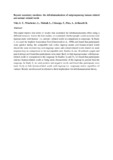Please use this identifier to cite or link to this item:
https://cris.library.msu.ac.zw//handle/11408/3584Full metadata record
| DC Field | Value | Language |
|---|---|---|
| dc.contributor.author | Viki, G. Tendayi | - |
| dc.contributor.author | Winchester, Laura | - |
| dc.contributor.author | Chisango, Tadios | - |
| dc.contributor.author | Pina, Afroditi | - |
| dc.contributor.author | Russell, Rebecca | - |
| dc.date.accessioned | 2019-04-29T12:43:57Z | - |
| dc.date.available | 2019-04-29T12:43:57Z | - |
| dc.date.issued | 2006 | - |
| dc.identifier.issn | 0278-016X | - |
| dc.identifier.uri | https://www.researchgate.net/publication/247839073 | - |
| dc.identifier.uri | http://hdl.handle.net/11408/3584 | - |
| dc.description.abstract | This paper reports four series of studies that examined the infrahumanization effect using a different measure. Across the four studies, we examined whether people would associate their ingroup more with human- (vs. animal-) related words in comparison to outgroups. In Study 1, we used the Implicit Association Test (Greenwald et al., 1998) and found that participants were quicker during the compatible task (when ingroup names and human-related words shared the same response key and outgroup names and animal-related words shared the same response key) in comparison to the incompatible task. Studies 2a and 2b utilized a paper and pencil design and found that participants were more likely to link ingroup names with human-related words in comparison to the outgroup. In Studies 3a and 3b, we found that participants selected human-related words as being more characteristic of the ingroup in general than the outgroup. In Study 4, we used positive and negative words and found that participants were more likely to link human-related words with ingroup (vs. outgroup) names regardless of valence. Results are discussed in relation to their implications for infrahumanization theory. | en_US |
| dc.description.uri | https://psycnet.apa.org/record/2006-22561-003 | |
| dc.language.iso | en | en_US |
| dc.publisher | Guilford Press | en_US |
| dc.relation.ispartofseries | Social Cognition;Vol. 24; No. 6: p. 753-775 | - |
| dc.subject | Infrahumanization | en_US |
| dc.title | Beyond secondary emotions: the infrahumanization of outgroupsusing human–related andanimal–related words | en_US |
| dc.type | Article | en_US |
| item.openairetype | Article | - |
| item.grantfulltext | open | - |
| item.cerifentitytype | Publications | - |
| item.languageiso639-1 | en | - |
| item.fulltext | With Fulltext | - |
| item.openairecristype | http://purl.org/coar/resource_type/c_18cf | - |
| Appears in Collections: | Research Papers | |
Files in This Item:
| File | Description | Size | Format | |
|---|---|---|---|---|
| Beyond secondary emotions.pdf | Abstract | 91.26 kB | Adobe PDF |  View/Open |
Page view(s)
10
checked on Jul 26, 2024
Download(s)
2
checked on Jul 26, 2024
Google ScholarTM
Check
Items in MSUIR are protected by copyright, with all rights reserved, unless otherwise indicated.


